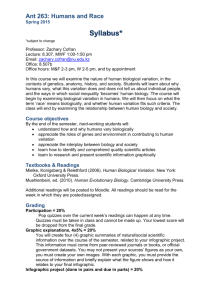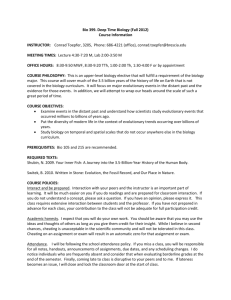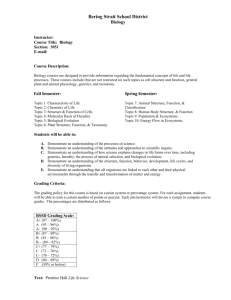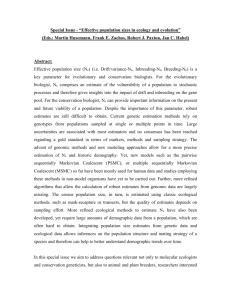Syllabus-Spring 2016 - Lawn Chair Anthropology
advertisement
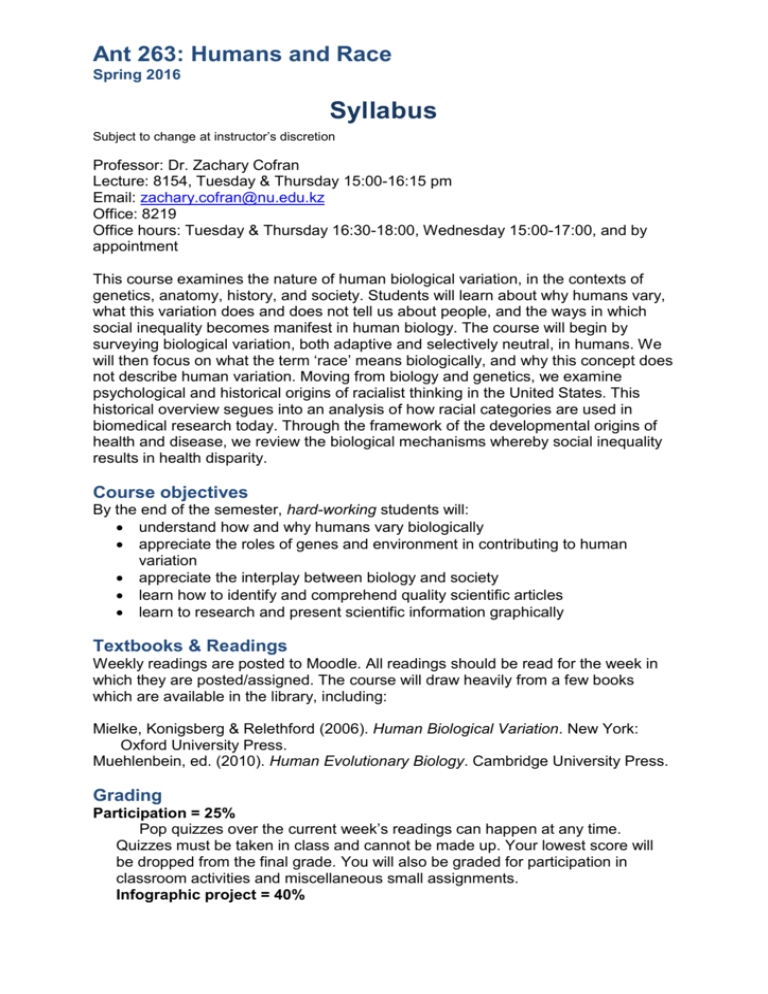
Ant 263: Humans and Race Spring 2016 Syllabus Subject to change at instructor’s discretion Professor: Dr. Zachary Cofran Lecture: 8154, Tuesday & Thursday 15:00-16:15 pm Email: zachary.cofran@nu.edu.kz Office: 8219 Office hours: Tuesday & Thursday 16:30-18:00, Wednesday 15:00-17:00, and by appointment This course examines the nature of human biological variation, in the contexts of genetics, anatomy, history, and society. Students will learn about why humans vary, what this variation does and does not tell us about people, and the ways in which social inequality becomes manifest in human biology. The course will begin by surveying biological variation, both adaptive and selectively neutral, in humans. We will then focus on what the term ‘race’ means biologically, and why this concept does not describe human variation. Moving from biology and genetics, we examine psychological and historical origins of racialist thinking in the United States. This historical overview segues into an analysis of how racial categories are used in biomedical research today. Through the framework of the developmental origins of health and disease, we review the biological mechanisms whereby social inequality results in health disparity. Course objectives By the end of the semester, hard-working students will: understand how and why humans vary biologically appreciate the roles of genes and environment in contributing to human variation appreciate the interplay between biology and society learn how to identify and comprehend quality scientific articles learn to research and present scientific information graphically Textbooks & Readings Weekly readings are posted to Moodle. All readings should be read for the week in which they are posted/assigned. The course will draw heavily from a few books which are available in the library, including: Mielke, Konigsberg & Relethford (2006). Human Biological Variation. New York: Oxford University Press. Muehlenbein, ed. (2010). Human Evolutionary Biology. Cambridge University Press. Grading Participation = 25% Pop quizzes over the current week’s readings can happen at any time. Quizzes must be taken in class and cannot be made up. Your lowest score will be dropped from the final grade. You will also be graded for participation in classroom activities and miscellaneous small assignments. Infographic project = 40% Ant 263: Humans and Race Spring 2016 The major term project is an infographic that presents empirical data illustrating one way in which humans vary. This project will be done with one partner, with whom you will work closely on the following: Brainstorming meeting (5%) Early in the semester, you and your partner will meet with the professor to decide upon a topic for your project. Article summaries (4 x 5% = 20%) For each of four specific aspects of your project topic, you will write brief summaries of either peer-reviewed journal articles or official government data. You and your partner must work together to ensure that 1) you are not writing about the same article, and 2) that your separate articles logically relate to each other. Infographic presentation (15%) You and your partner will synthesize and present your summaries in the form of an infographic. Presentations will take place on 19 and 21 April. Exam 1 = 15% In class 03 March Exam 2 = 20% Finals week Except for a few points on the exams, there will be no opportunities for extra credit. Grading scale A AB+ B BC+ C 95-%100% 90%-94.9% 85%-89.9% 80%-84.9% 75%-79.9% 70%-74.9% 65%-69.9% CD+ D F 60%-64.9% 55%-59.9% 50%-54.9% 0%-49.9% Excellent, exceeds the highest standards in the assignment or course Excellent; meets the highest standards for the assignment or course Very good; meets high standards for the assignment or course Good; meets most of the standards for the assignment or course More than adequate; shows some reasonable command of the material Acceptable; meets basic standards for the assignment or course Acceptable; meets some of the basic standards for the assignment or course Acceptable, while falling short of meeting basic standards in several ways Minimally acceptable Minimally acceptable; lowest passing Did not satisfy the basic requirements of the course Late policy Work turned in late will not be accepted. I do not grant extensions. You must be in attendance for quizzes and the midterm exam. Academic Integrity All work you submit must be your own. You may discuss assignments with colleagues, but you may not turn in the same work (except on the Infographic; details to follow). When you use references, other people’s ideas, and especially other people’s direct words, you absolutely must cite them. Failure to cite is plagiarism which will result in your failure of the assignment. Plagiarism and other academic misconduct will be reported to the SHSS for possibly further disciplinary action. Ant 263: Humans and Race Spring 2016 Attendance Whether you attend each class is ultimately up to you, but you will do better if you come to class. Note that there will be quizzes every week which cannot be made up if missed. Keeping up with course material and due dates are ultimately your responsibility. Please do not waste either your or my time by sleeping in class (you will be asked to leave). Schedule of topics & assignments* *Schedule and content subject to change Due dates in red 12-14 January: Race and ethnicity Readings Kottak, 2007. Chapter 4: Ethnicity and Race. Mirror for Humanity. Pages 59-84. Race, Ethnicity, and Genetics Working Group, 2005. The use of racial, ethnic, and ancestral groups in human genetics research. American Journal of Human Genetics 77: 519-532. 19-21 January: Evolution Readings Futuyma, 2010. Evolutionary Theory. In Human Evolutionary Biology. Muehlenbein, ed. Pages 3-16. Stinson et al., 2012. Human biology: An evolutionary and biocultural perspective. In, Human Biology: An Evolutionary and Biocultural Perspective. Pages 3-22. 26-28 January: Skin Readings Jablonski, 2004. The evolution of human skin and skin color. Annual Review of Anthropology 33: 585-623. Elias and Williams, 2013. Re-appraisal of current theories for the development and loss of epidermal pigmentation in hominins and modern humans. Journal of Human Evolution 64: 687. Jablonski and Chaplin, 2013. Epidermal pigmentation in the human lineage is an adaptation to ultraviolet radiation. Journal of Human Evolution 65: 671. 02-04 February: Body size and shape Infographic brainstorming meeting (week of 01 February) Readings Leonard and Katzmarzyk, 2010. Body Size and Shape: Climatic and Nutritional Influences on Human Body Morphology. In Human Evolutionary Biology. Muehlenbein, ed. Pages 157-169. Brutsaert, 2010. Human Adaptation to High Atitude. In Human Evolutionary Biology. Muehlenbein, ed. Pages 170-191. 09-11 February: Food Readings Mielke et al., 2006. Lactase Restriction and Persistence. In Human Biological Variation. Pages 177-181. Ant 263: Humans and Race Spring 2016 Tishkoff et al., 2007. Convergent adaptation of human lactase persistence in Africa and Europe. Nature Genetics 39: 31. Pontzer et al., 2012. Hunter-gatherer energetics and human obesity. PLoS One 7:e40503. Gut microbiome of the Hadza hunter-gatherers. Nature Communications 5:3654 16-18 February: Genetic variation Summary 1: Variation, due Friday 19 February at midnight Readings Li et al., 2008. Worldwide human relationships inferred from genome-wide patterns of variation. Science 319: 1100-1104 Relethford, 2009. Race and global patterns of phenotypic variation. American Journal of Physical Anthropology 139: 166-22. Pääbo, 2015. The diverse origins of the human gene pool. Nature Reviews Genetics 16:313-314. 23-25 February: Variation ≠ Race Summary 2: Biology, due Friday 26 February at midnight Readings Shiao et al., 2012. Genomic challenge to the social construction of race. Sociological Theory 30: 67-88. Fujimura et al., 2014. Clines without classes: How to make sense of human variation. Sociological Theory 32: 208-227. 01-03 March: Exam Exam 1 in class Thursday 03 March Reading Marks, 2010. Ten facts about human variation. In, Human Evolutionary Biology. Muehlenbein, ed. Pages 265-276. 08-10 March: Racial thinking 08 March – Women’s Day – no class Readings Hirschfeld, 1998. Natural assumptions: Race, essence, and taxonomies of human kinds. Social Research 65: 331. Blakey, 1999. Scientific racism and the biological concept of race. Literature and Psychology 45: 29-43. 15-17 March: Eugenics Summary 3: Environment, due Friday 18 March at midnight Readings Kauffman, 2009. Intelligence testing: The evolving landscape of IQ testing. Beautiful Minds (blog). http://bit.ly/1VYNc8T Micklos and Carlson, 2000. Engineering American society: The lesson of eugenics. Nature Reviews Genetics 1: 153-158. Check-Haydn, 2013. Ethics: Taboo genetics. Nature 502: 22-24 March: Spring break – no classes Ant 263: Humans and Race Spring 2016 29-31 March: Race, health and society Summary 4: Society, due Friday 01 April at midnight Readings Duster, 2005. Race and reification in Science. Science 307: 1050. Phelan et al., 2013. The Genomic Revolution and beliefs about essential racial differences: A Backdoor to Eugenics? American Sociological Review 78: 167. Cooper, 2013. Race in biological and biomedical research. Cold Spring Harbor Perspectives in Medicine. doi: 10.1101/cshperspect.a008573. 05-07 April: Developmental Origins of Health and Disease Readings Hale and Barker, 2001. The thrifty phenotype hypothesis. British Medical Bulletin 60: 5-20. Kuzawa and Sweet, 2009. Epigenetics and the embodiment of race: Developmental origins of US racial disparities in cardiovascular health. American Journal of Human Biology 21: 2. 12-14 April: AAPA Conference Activities to be announced 19-21 April: Infographics Infographics presented in class 19 & 21 April 26-28 April: Kazakhstan Facchini et al., 2007. Prevalence of overweight and cardiovascular risk factors in rural and urban children from Central Asia: The Kazakhstan Health and Nutrition Examination Survey. American Journal of Human Biology 19: 809820. Kulkayeva et al., 2012. Cardiovascular disease risk factors among rural Kazakh population. Nagoya Journal of Medical Science 74: 51-61. Exam 2 (Finals week)
